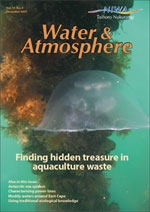PDF of this article (157 KB)




NZMST Teacher Fellow studies carbon dioxide levels – and more!
Shirley Dudli will always remember 2007 as the year she took the plunge into the world of NIWA science as a New Zealand Science, Mathematics and Technology Teacher Fellow. After 10 years teaching secondary school science and biology, Shirley found a year immersed in the diverse world of NIWA science both challenging and invigorating. The bells and timetables of Hamilton’s Fairfield College were replaced by a quiet office at NIWA Hamilton, spiced with visits to other NIWA sites and various remote field locations throughout New Zealand.
During her project, ‘Carbon dioxide in the atmosphere and ocean’, Shirley was busy learning about the development of carbon dioxide measurement and monitoring, both in New Zealand and internationally, and improving her understanding of the impact of changing CO2 levels on the earth system.
Early in the year she travelled to Dunedin to learn about NIWA’s work in measuring CO2 in the ocean; unfortunately, poor weather conditions meant the ocean-going leg of this trip had to be cancelled and her work was confined to laboratory-based demonstrations of pCO2 (partial pressure of CO2), pH, and alkalinity testing. She got the real ocean-going experience in August when she spent 10 days working with scientists collecting and analysing seawater and ocean sedimentsamples on NIWA’s research vessel Tangaroa. While at NIWA in Wellington, she visited the Baring Head Clean Air Station and spent time at the Greta Point gas analysis facility, where she discovered the complexities of gathering and analysing atmospheric samples for a range of different gases. To complete her work on increased CO2 levels, she spent a week with AgResearch in Palmerston North, where scientists are working on the impact of elevated CO2 levels on pasture growth.
To add to her experience, Shirley got involved in some of NIWA’s other projects, including river sampling in field trials for treatment of didymo in Princhester Creek, Southland, and sampling sediment from Lake Okaro. She also helped out with Water & Atmosphere by providing the curriculum links to go with each article.
Shirley says of her year at NIWA, “I’m looking forward to sharing my experiences and new knowledge with students and colleagues when I return to school in 2008. My thanks to all the NIWA staff for their collegiality and patience, the Royal Society of New Zealand for their on-going support and guidance, the New Zealand Government for funding such a fantastic scheme, and the Fairfield College community for their continued encouragement and moral support.”
For futher information about Teacher Fellows at NIWA, contact: Dr Julie Hall, 07-856 1703, [email protected]
Cool conference for kids
When Mireille Consalvey was 10, she decided that she wanted to be a marine biologist – the idea planted by her mum after Mireille announced she wanted a job involving snorkelling. Though she is rarely submerged in water these days, her current post as a seamount scientist proves that from small acorns mighty oaks may grow.
In 2001, teacher Nik Edwards and his class at Raumati South School had a Eureka! moment and decided to organise a careers conference for kids, profiling a wealth of career options with experts talking directly to children about what they do. Alongside fellow scientists Kareen Schnabel and Craig Stevens, Mireille participated in this year’s conference, which profiled over 200 career choices ranging from bomb disposal to caringfor animals at the SPCA. They were each given an hour-long slot and free rein to introduce the children, aged 11 to 13, to what it means to be a scientist at NIWA.
Kareen and Mireille both talked about the biology of New Zealand’s underwater environment. Kareen highlighted some of the weird and wonderful creatures that she collects and catalogues as part of her role as manager of the NIWA Invertebrate Collection. Meanwhile, by the wonders of modern technology and using footage from NIWA’s Deep-Towed Imaging System, Mireille took the children down to 1000 m to see some of the marine life that lives on New Zealand’s underwater mountains. Proving that physics really is fun, Craig put a real face to the often imagined caricature of a physics boffin. Against a backdrop of marine physics, Craig discussed how ocean exploration has changed over the centuries, from trade and migration, to exploitation, to conservation and sustainability. And, with one child announcing at the end of Craig’s talk that he too wanted to be a marine physicist, it could be that our successors are already lining up.
For further information, contact: Dr Mireille Consalvey, 0-4-386 0853, [email protected] Kareen Schnabel, 0-4-386 0862, [email protected] Dr Craig Stevens, 0-4-386 0476, [email protected]
